Investigating the Underlying Effect of Thermal Modification on Shrinkage Behavior of Bamboo Culm by Experimental and Numerical Methods
Abstract
1. Introduction
2. Materials and Methods
2.1. Specimen Preparation and Pre-Treatment
2.2. Determination of Heating Range
2.3. Experimental Procedure for Shrinkage Test
2.4. FTIR Analysis
3. Experimental Results
3.1. Effect of Thermal Modification on Physical Changes
3.2. FTIR Analysis
4. Investigation of Thermal Contraction by FEM
4.1. Shrinkage Modeling
4.2. Material Parameters
4.3. Geometrical Modeling and Boundary Conditions
4.4. FE Mesh
5. Numerical Results
5.1. Strain Field Analysis
5.2. Analysis of Effective Strain Distribution
5.3. Analysis of Bamboo Fracture Mechanisms due to Thermal Contraction
5.4. Future Recommendation
6. Conclusions
Author Contributions
Funding
Institutional Review Board Statement
Informed Consent Statement
Data Availability Statement
Conflicts of Interest
References
- Sassu, M.; De Falco, A.; Giresini, L.; Puppio, M.L. Structural solutions for low-cost bamboo frames: Experimental tests and constructive assessments. Materials 2016, 9, 346. [Google Scholar] [CrossRef] [PubMed]
- Van der Lugt, P.; van den Dobbelsteen, A.A.J.F.; Janssen, J.J. An environmental, economic and practical assessment of bamboo as a building material for supporting structures. Constr. Build. Mater. 2006, 20, 648–656. [Google Scholar] [CrossRef]
- Ghavami, K. Bamboo: Low cost and energy saving construction materials. In Proceedings of the International Conference on Modern Bamboo Structures, Changsha, China, 28–30 October 2008. [Google Scholar]
- Shao, Z.; Wang, F. Fracture Mechanics of Plant Materials; Science Press: Beijing, China, 2012. [Google Scholar]
- Kappel, R.; Mattheck, C.; Bethge, K.; Tesari, I. Bamboo as a composite structure and its mechanical failure behaviour. Wit Trans. Ecol. Environ. 2004, 73, 9. [Google Scholar]
- Huang, Y.S.; Hsu, F.L.; Lee, C.M.; Juang, J.Y. Failure mechanism of hollow tree trunks due to cross-sectional flattening. R. Soc. Open Sci. 2017, 4, 160972. [Google Scholar] [CrossRef] [PubMed]
- Spatz, H.C.; Niklas, K.J. Modes of failure in tubular plant organs. Am. J. Bot. 2013, 100, 332–336. [Google Scholar] [CrossRef] [PubMed]
- Trujillo, D.; Jangra, S.; Gibson, J.M. Flexural properties as a basis for bamboo strength grading. Proc. Inst. Civ. Eng. Struct. Build. 2017, 170, 284–294. [Google Scholar] [CrossRef]
- Ribeiro, R.A.; Ribeiro, M.G.; Miranda, I.P. Bending strength and nondestructive evaluation of structural bamboo. Constr. Build. Mater. 2017, 146, 38–42. [Google Scholar] [CrossRef]
- Schott, W. Bamboo in the Laboratory. Tech. Np. Schott 2006. Available online: http://www.powerfibers.com/assets/files/BAMBOO%20IN%20THE%20LABORATORY.pdf (accessed on 12 November 2020).
- Dietsch, P.; Gamper, A.; Merk, M.; Winter, S. Monitoring building climate and timber moisture gradient in large-span timber structures. J. Civ. Struct. Health Monit. 2014, 5, 153–165. [Google Scholar] [CrossRef]
- Li, H.; Xian, Y.; Deng, J.; Cheng, H.; Chen, F.; Wang, G. Evaluation of water absorption and its influence on the physical-mechanical properties of bamboo-bundle laminated veneer lumber. BioResources 2016, 11, 1359–1368. [Google Scholar] [CrossRef][Green Version]
- Chen, K.; Qiu, H.; Sun, M.; Lam, F. Experimental and numerical study of moisture distribution and shrinkage crack propagation in cross section of timber members. Constr. Build. Mater. 2019, 221, 219–231. [Google Scholar] [CrossRef]
- Huang, P.; Chang, W.S.; Ansell, M.P.; Bowen, C.R.; Chew, J.Y.; Adamaki, V. Thermal and hygroscopic expansion characteristics of bamboo. Proc. Inst. Civ. Eng. Struct. Build. 2018, 171, 463–471. [Google Scholar] [CrossRef]
- Azadeh, A.; Ghavami, K. The influence of heat on shrinkage and water absorption of Dendrocalamus giganteus bamboo as a functionally graded material. Constr. Build. Mater. 2018, 186, 145–154. [Google Scholar] [CrossRef]
- Xu, Q.; Harries, K.; Li, X.; Liu, Q.; Gottron, J. Mechanical properties of structural bamboo following immersion in water. Eng. Struct. 2014, 81, 230–239. [Google Scholar] [CrossRef]
- Jiang, Z.; Wang, H.; Tian, G.; Yu, Y. Sensitivity of several selected mechanical properties of moso bamboo to moisture content change under the fibre saturation point. BioResources 2012, 7, 5048–5058. [Google Scholar] [CrossRef]
- Motoi, O. Study on the properties of bamboo stem (part 9): On the relation between compressive strength parallel to grain and moisture content of bamboo splint. Bull. Kyushu Univ. For. 1953, 22, 87–108. [Google Scholar]
- Zhang, Y.M.; Yu, Y.L.; Yu, W.J. Effect of thermal treatment on the physical and mechanical properties of Phyllostachys pubescen bamboo. Eur. J. Wood Wood Prod. 2013, 71, 61–67. [Google Scholar] [CrossRef]
- Yu, H.Q.; Jiang, Z.H.; Hse, C.Y.; Shupe, T.F. Selected physical and mechanical properties of moso bamboo (Phyllostachys pubescens). J. Trop. For. Sci. 2008, 1, 258–263. [Google Scholar]
- Lv, H.; Chen, M.; Ma, X.; Li, J.; Zhang, B.; Fang, C.; Fei, B. Effects of Different Drying Methods on Bamboo’s Physical and Mechanical Properties. For. Prod. J. 2018, 68, 445–451. [Google Scholar]
- Yang, T.H.; Lee, C.H.; Lee, C.J.; Cheng, Y.W. Effects of different thermal modification media on physical and mechanical properties of moso bamboo. Constr. Build. Mater. 2016, 119, 251–259. [Google Scholar] [CrossRef]
- Taylor, D.; Kinane, B.; Sweeney, C.; Sweetnam, D.; O’Reilly, P.; Duan, K. The biomechanics of bamboo: Investigating the role of the nodes. Wood Sci. Technol. 2015, 49, 345–357. [Google Scholar] [CrossRef]
- Amada, S.; Munekata, T.; Nagase, Y.; Ichikawa, Y.; Kirigai, A.; Zhifei, Y. The mechanical structures of bamboos in viewpoint of functionally gradient and composite materials. J. Compos. Mater. 1996, 30, 800–819. [Google Scholar] [CrossRef]
- Liese, W. Protection of bamboo in service. World Bamboo Ratt. 2003, 1, 29–33. [Google Scholar]
- Liese, W. Preservation of a bamboo culm in relation to its structure. World Bamboo Ratt. 2005, 3, 17–21. [Google Scholar]
- Janssen, J.J. Designing and Building with Bamboo; International Network for Bamboo and Rattan; Technical University of Eindhoven: Eindhoven, The Netherlands, 2000. [Google Scholar]
- Liese, W.; Kumar, S. Bamboo Preservation Compendium; CIBART: New Delhi, India, 2003. [Google Scholar]
- Askarinejad, S.; Kotowski, P.; Shalchy, F.; Rahbar, N. Effects of humidity on shear behavior of bamboo. Theor. Appl. Mech. Lett. 2015, 5, 236–243. [Google Scholar] [CrossRef]
- Silva, E.C.; Walters, M.C.; Paulino, G.H. Modeling bamboo as a functionally graded material: Lessons for the analysis of affordable materials. J. Mater. Sci. 2006, 41, 6991–7004. [Google Scholar] [CrossRef]
- Keogh, L.; O’Hanlon, P.; O’Reilly, P.; Taylor, D. Fatigue in bamboo. Int. J. Fatigue 2015, 75, 51–56. [Google Scholar] [CrossRef]
- Adhikari, R.C.; Wood, D.H.; Sudak, L. Low-cost bamboo lattice towers for small wind turbines. Energy Sustain. Dev. 2015, 28, 21–28. [Google Scholar] [CrossRef]
- Paraskeva, T.S.; Grigoropoulos, G.; Dimitrakopoulos, E.G. Design and experimental verification of easily constructible bamboo footbridges for rural areas. Eng. Struct. 2017, 143, 540–548. [Google Scholar] [CrossRef]
- Molari, L.; García, J.J. On the radial variation of the transverse mechanical properties of bamboo. J. Build. Eng. 2021, 33, 101557. [Google Scholar] [CrossRef]
- Ramful, R.; Sakuma, A. Investigation of the effect of inhomogeneous material on the fracture mechanisms of bamboo by finite element method. Materials 2020, 13, 5039. [Google Scholar] [CrossRef] [PubMed]
- Tjeerdsma, B.F.; Boonstra, M.; Pizzi, A.; Tekely, P.; Militz, H. Characterisation of thermally modified wood: Molecular reasons for wood performance improvement. Holz Als Roh Und Werkst. 1998, 56, 149. [Google Scholar] [CrossRef]
- Boonstra, M.J.; Tjeerdsma, B. Chemical analysis of heat treated softwoods. Holz Als Roh Und Werkst. 2006, 64, 204. [Google Scholar] [CrossRef]
- Khalil, H.A.; Bhat, I.U.; Jawaid, M.; Zaidon, A.; Hermawan, D.; Hadi, Y.S. Bamboo fibre reinforced biocomposites: A review. Mater. Des. 2012, 42, 353–368. [Google Scholar] [CrossRef]
- Zaman, A.; Alén, R.; Kotilainen, R. Thermal Behavior of Scots Pine (Pinus Sylvestris) and Silver Birch (Betula Pendula) at 200-230. Wood Fiber Sci. 2007, 32, 138–143. [Google Scholar]
- Xu, G.; Wang, L.; Liu, J.; Wu, J. FTIR and XPS analysis of the changes in bamboo chemical structure decayed by white-rot and brown-rot fungi. Appl. Surf. Sci. 2013, 280, 799–805. [Google Scholar] [CrossRef]
- Emmanuel, V.; Odile, B.; Céline, R. FTIR spectroscopy of woods: A new approach to study the weathering of the carving face of a sculpture. Spectrochim. Acta Part A Mol. Biomol. Spectrosc. 2015, 136, 1255–1259. [Google Scholar] [CrossRef]
- Lao, W.; Li, G.; Zhou, Q.; Qin, T. Quantitative analysis of biomass in three types of wood-plastic composites by FTIR spectroscopy. BioResources 2014, 9, 6073–6086. [Google Scholar] [CrossRef]
- Cheng, S.; Huang, A.; Wang, S.; Zhang, Q. Effect of different heat treatment temperatures on the chemical composition and structure of Chinese fir wood. BioResources 2016, 11, 4006–4016. [Google Scholar] [CrossRef]
- Sikora, A.; Kačík, F.; Gaff, M.; Vondrová, V.; Bubeníková, T.; Kubovský, I. Impact of thermal modification on color and chemical changes of spruce and oak wood. J. Wood Sci. 2018, 64, 406–416. [Google Scholar] [CrossRef]
- Veiga, T.R.; Lima, J.T.; Dessimoni, A.L.; Pego, M.F.; Soares, J.R.; Trugilho, P.F. Different plant biomass characterizations for biochar production. Cerne 2017, 23, 529–536. [Google Scholar] [CrossRef]
- Dantas, T.L.; Rodrigues, A.E.; Moreira, R.F. Separation of carbon dioxide from flue gas using adsorption on porous solids. In Greenhouse Gases: Capturing, Utilization and Reduction; Liu, G., Ed.; IntechOpen Limited: London, UK, 2012; pp. 57–80. [Google Scholar]
- Afrin, T.; Tsuzuki, T.; Wang, X. UV absorption property of bamboo. J. Text. Inst. 2012, 103, 394–399. [Google Scholar] [CrossRef]
- Palombini, F.L.; de Araujo Mariath, J.E.; de Oliveira, B.F. Bionic design of thin-walled structure based on the geometry of the vascular bundles of bamboo. Thin Walled Struct. 2020, 155, 106936. [Google Scholar] [CrossRef]
- Askarinejad, S.; Kotowski, P.; Youssefian, S.; Rahbar, N. Fracture and mixed-mode resistance curve behavior of bamboo. Mech. Res. Commun. 2016, 78, 79–85. [Google Scholar] [CrossRef]
- Ghavami, K. Introduction to nonconventional materials and an historic retrospective of the field. In Nonconventional and Vernacular Construction Materials; Harries, K.A., Sharma, B., Eds.; Woodhead Publishing: Cambridge, UK, 2016; pp. 37–61. [Google Scholar]
- Hone, T.; Cahill, L.; Robinson, A.; Korde, C.; Taylor, D. The splitting of bamboo in response to changes in humidity and temperature. J. Mech. Behav. Biomed. Mater. 2020, 111, 103990. [Google Scholar] [CrossRef] [PubMed]
- Boonstra, M.J.; Van Acker, J.; Kegel, E.; Stevens, M. Optimisation of a two-stage heat treatment process: Durability aspects. Wood Sci. Technol. 2007, 41, 31–57. [Google Scholar] [CrossRef]
- Tang, T.; Zhang, B.; Liu, X.; Wang, W.; Chen, X.; Fei, B. Synergistic effects of tung oil and heat treatment on physicochemical properties of bamboo materials. Sci. Rep. 2019, 9, 1–11. [Google Scholar] [CrossRef] [PubMed]
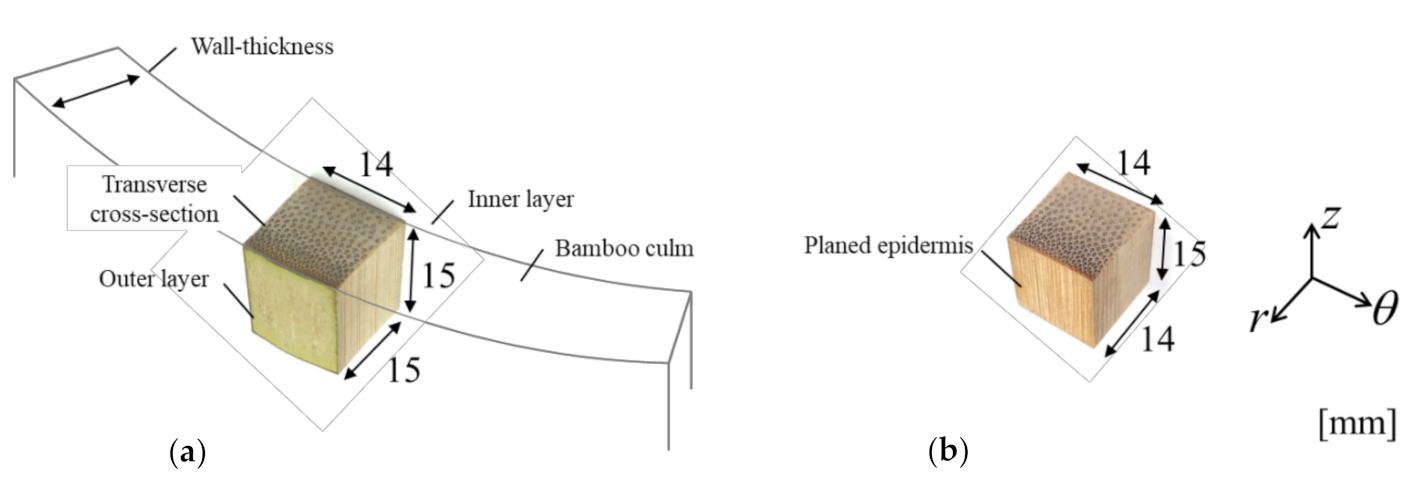
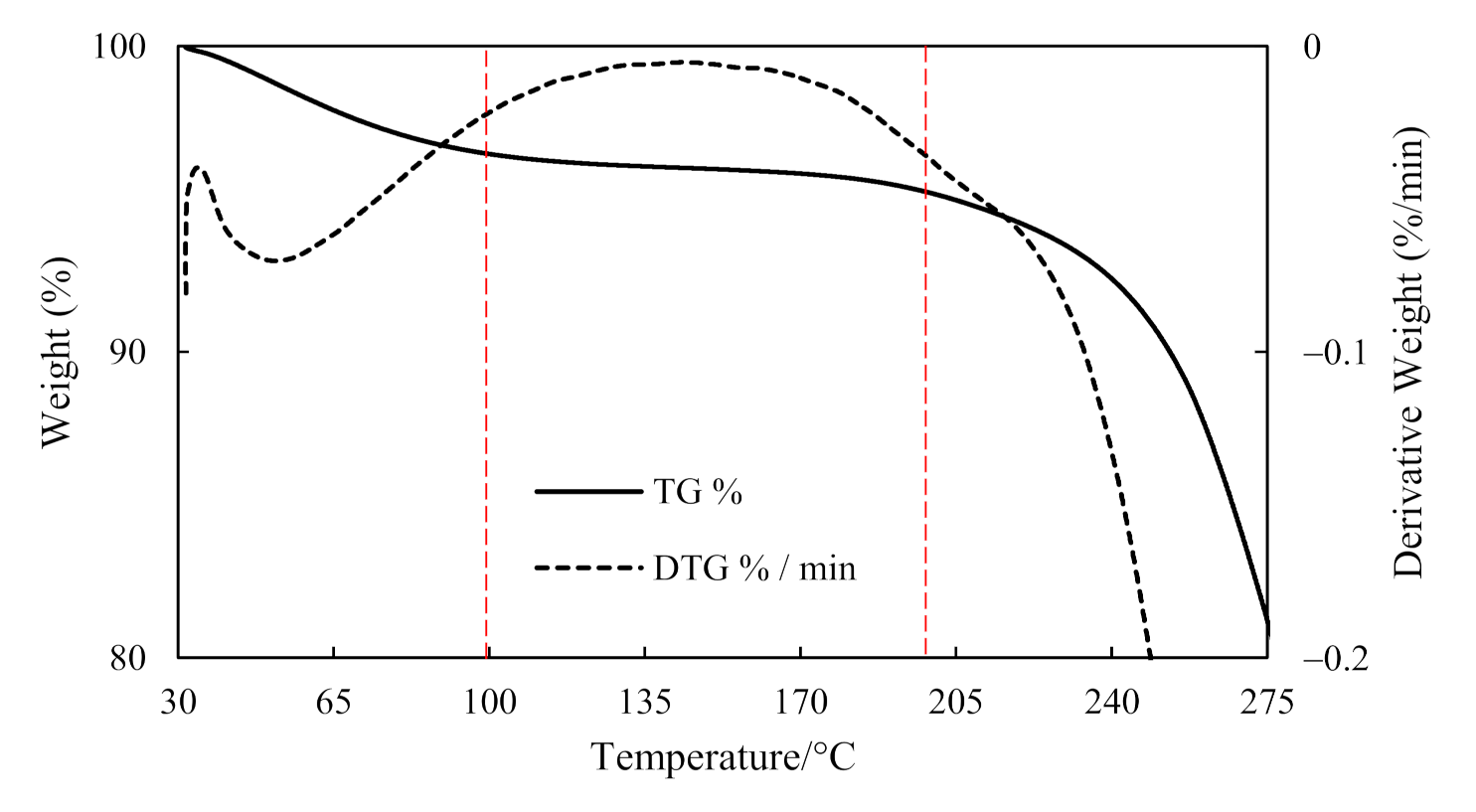
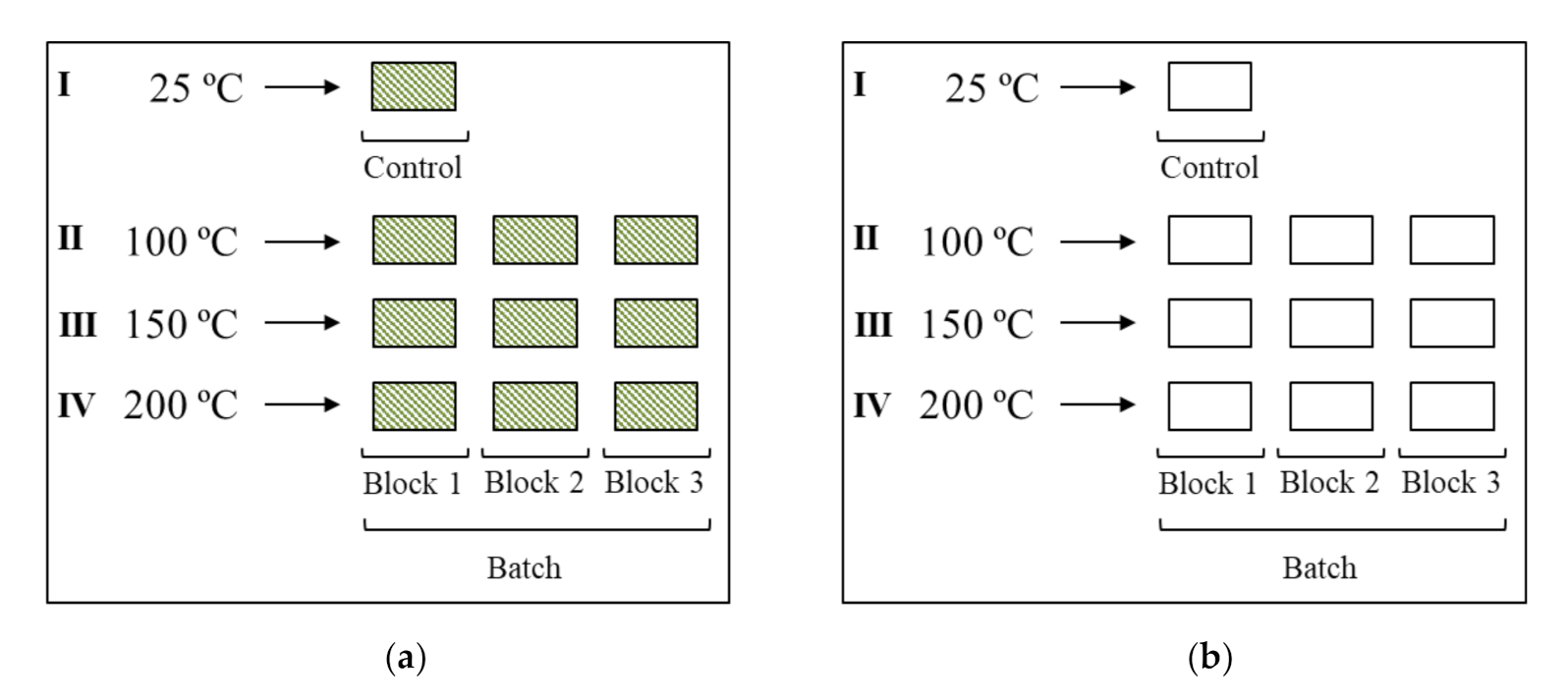
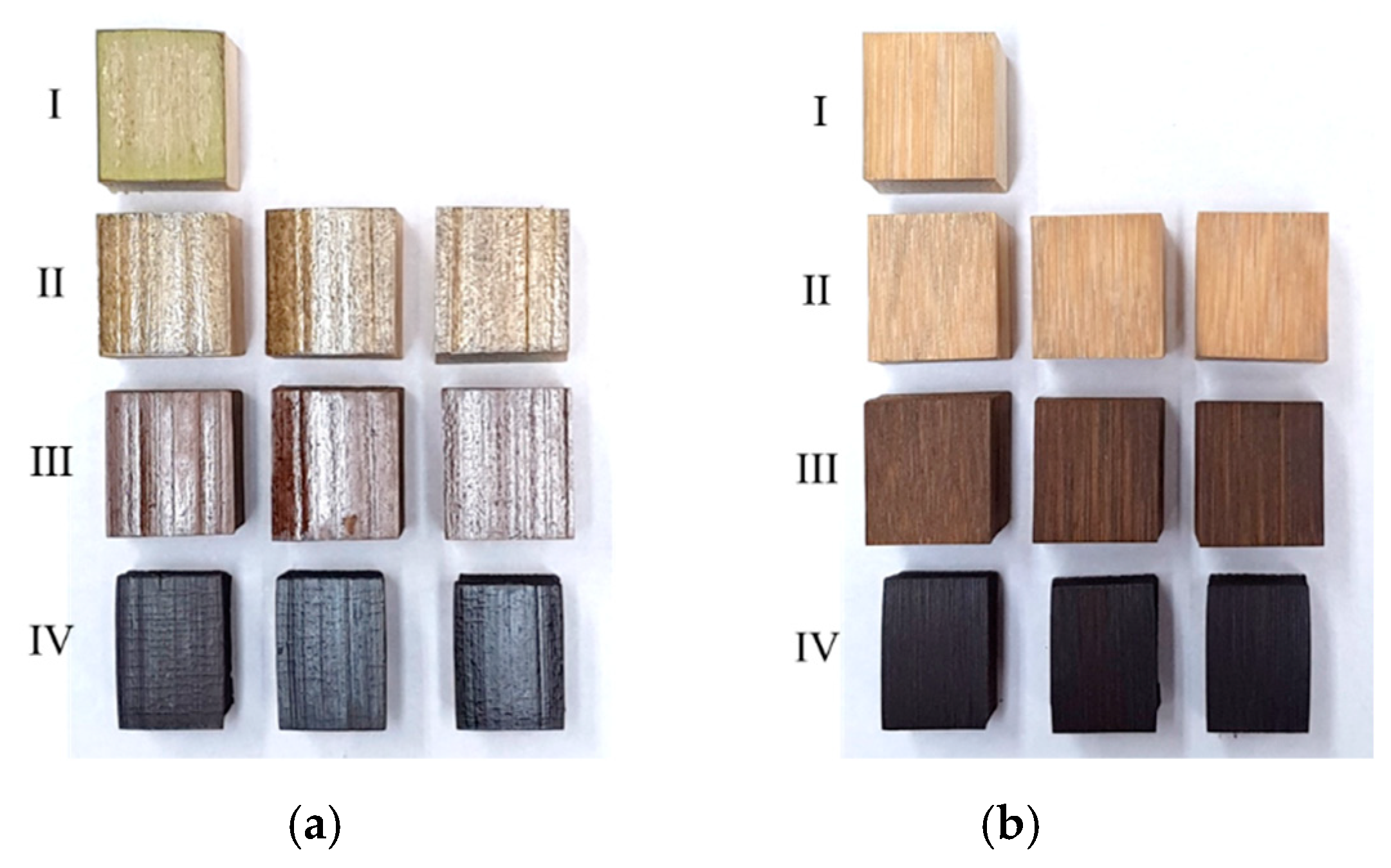
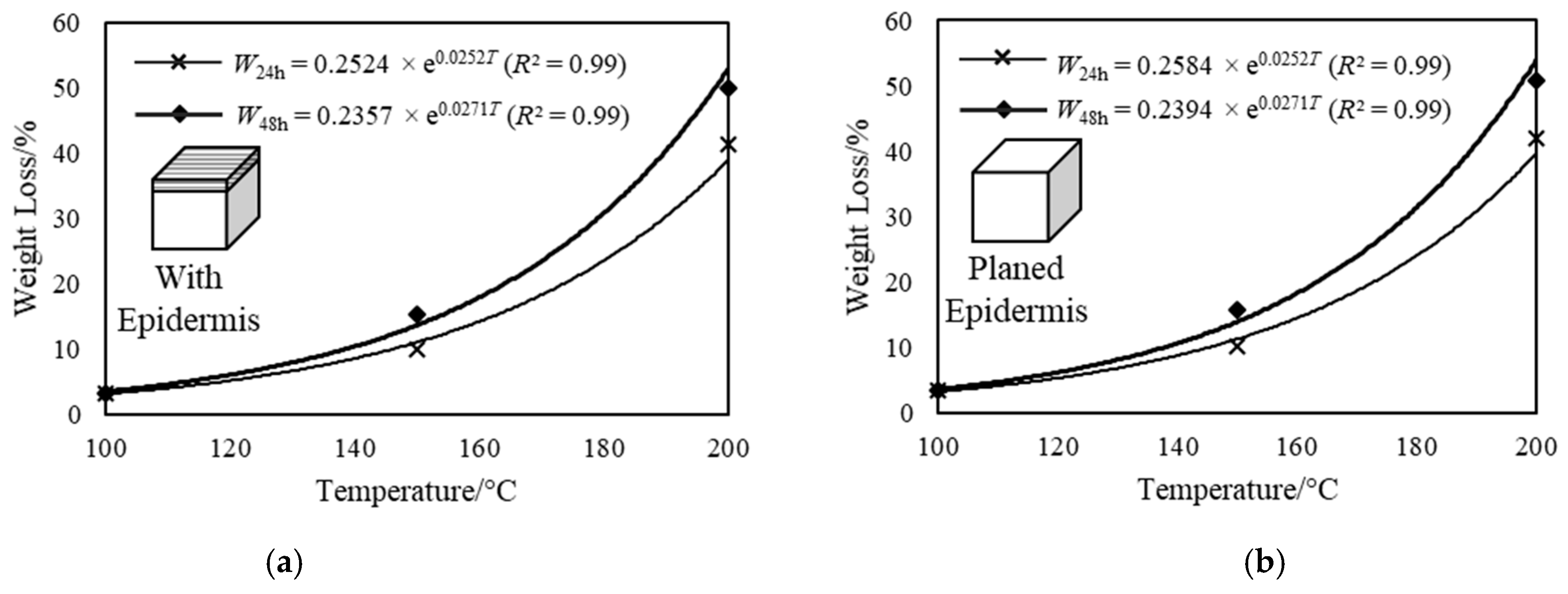
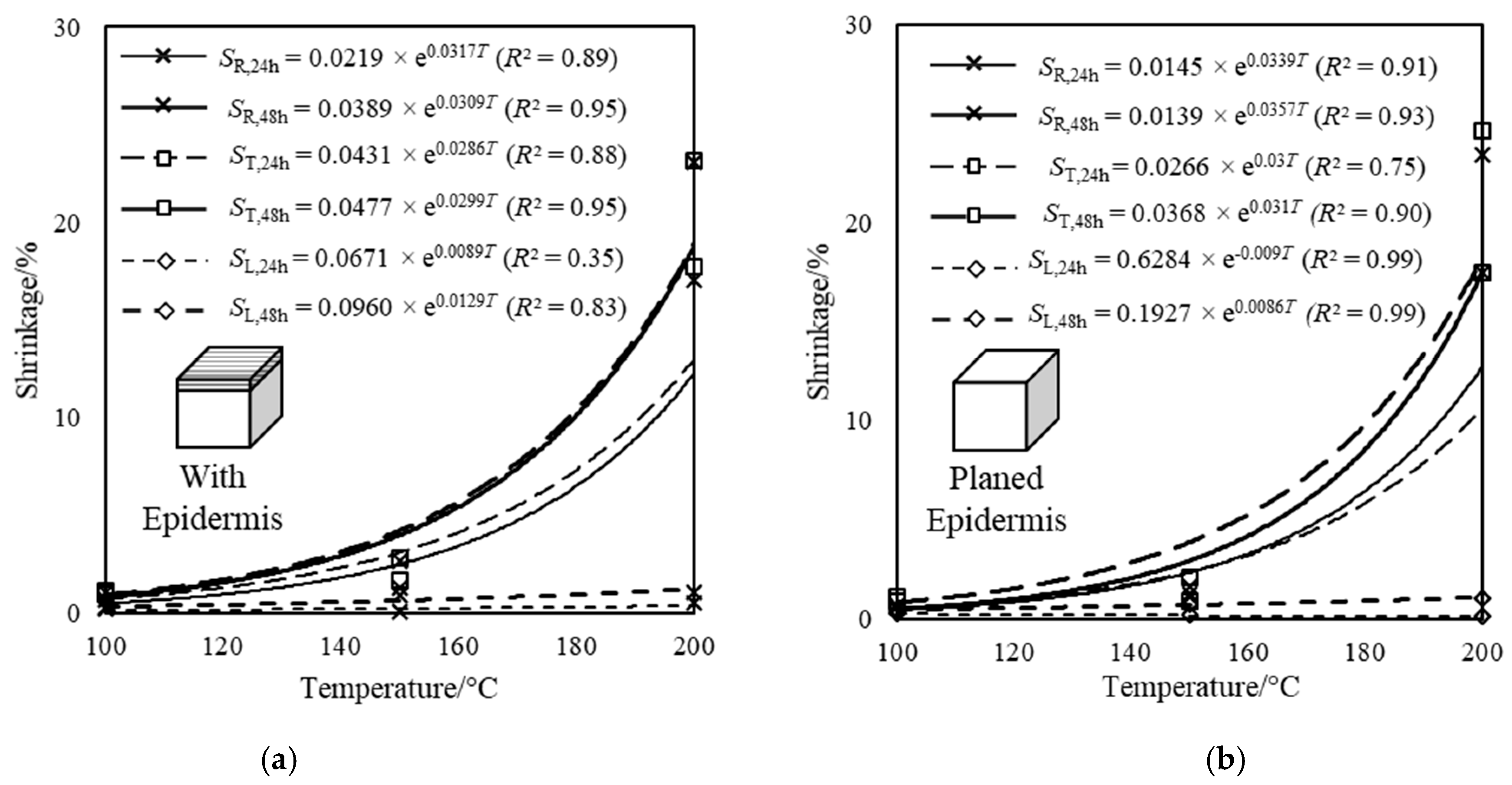
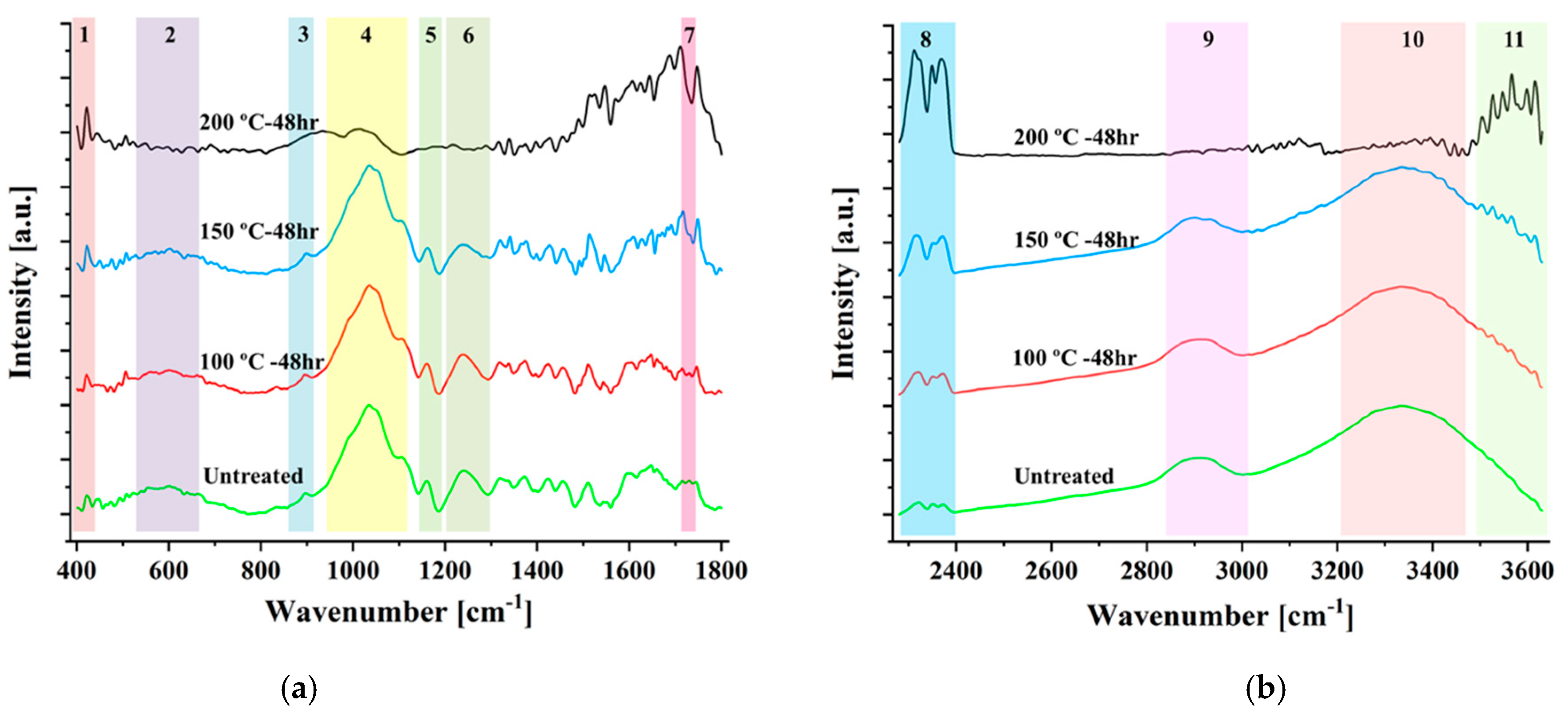
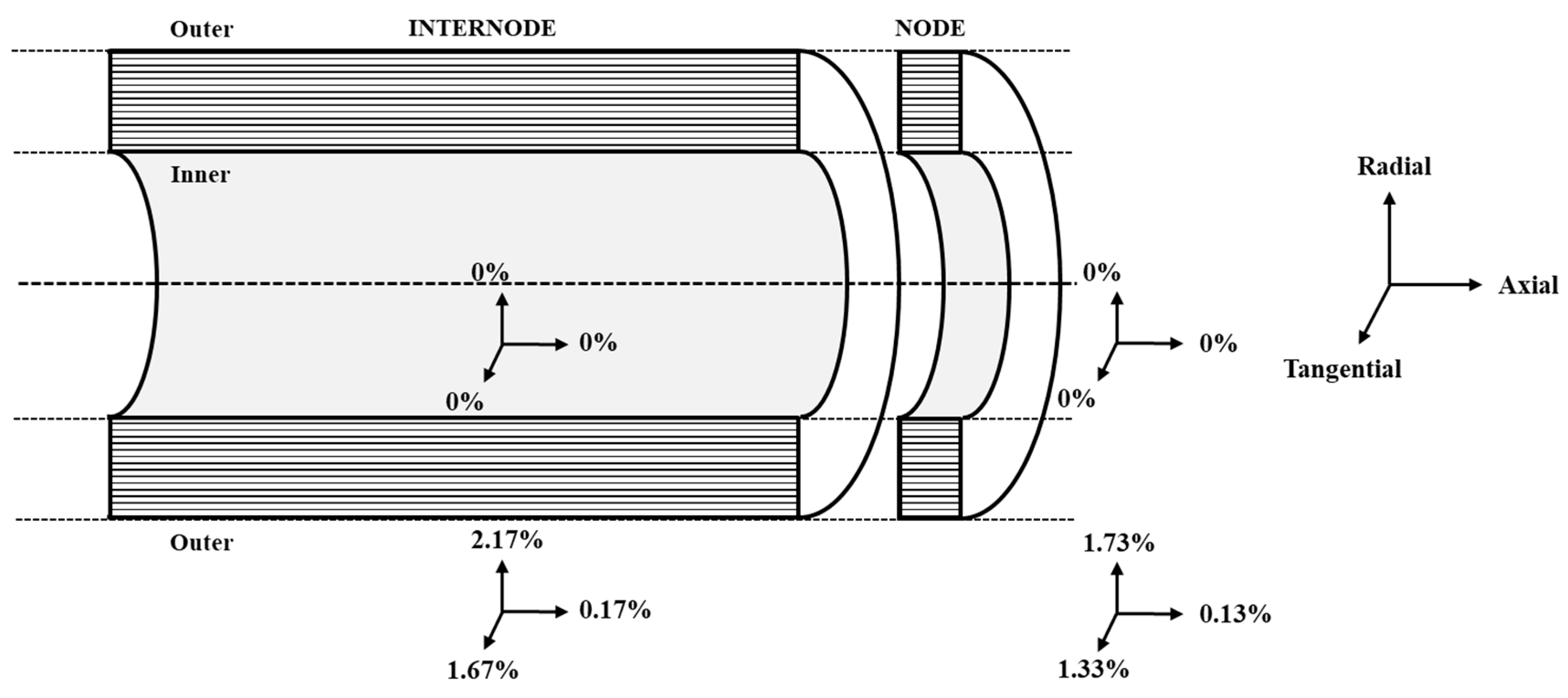
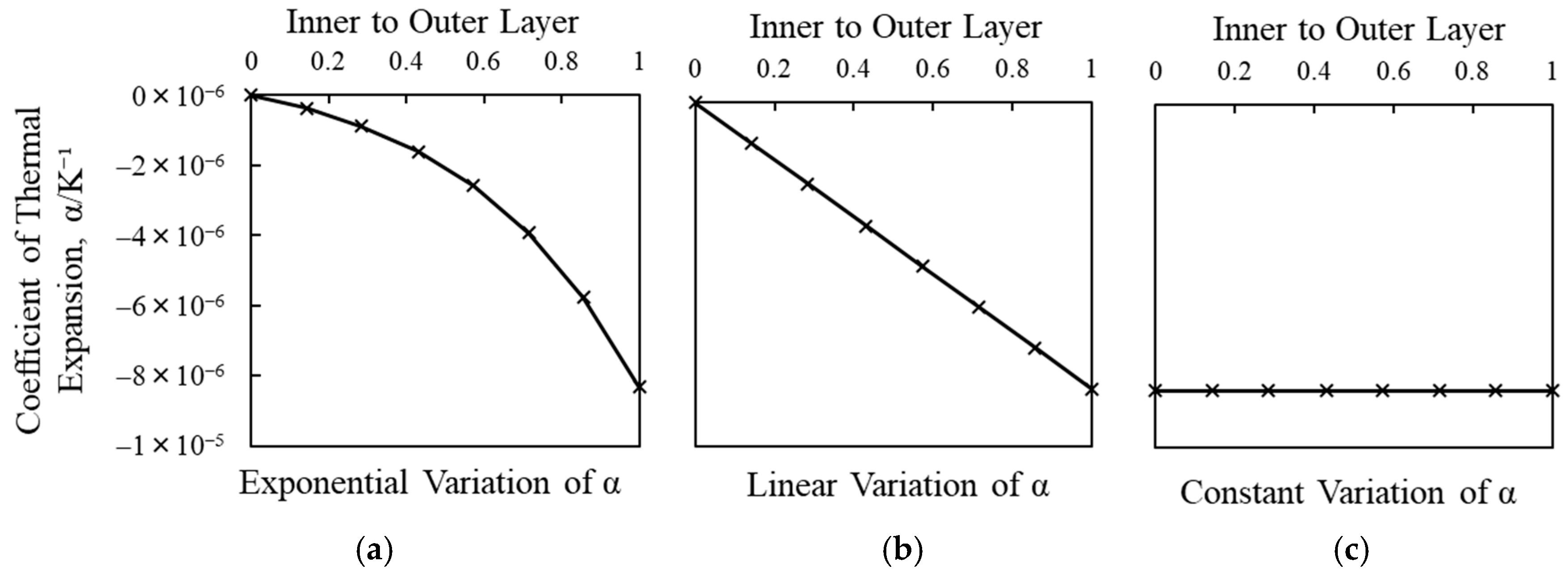
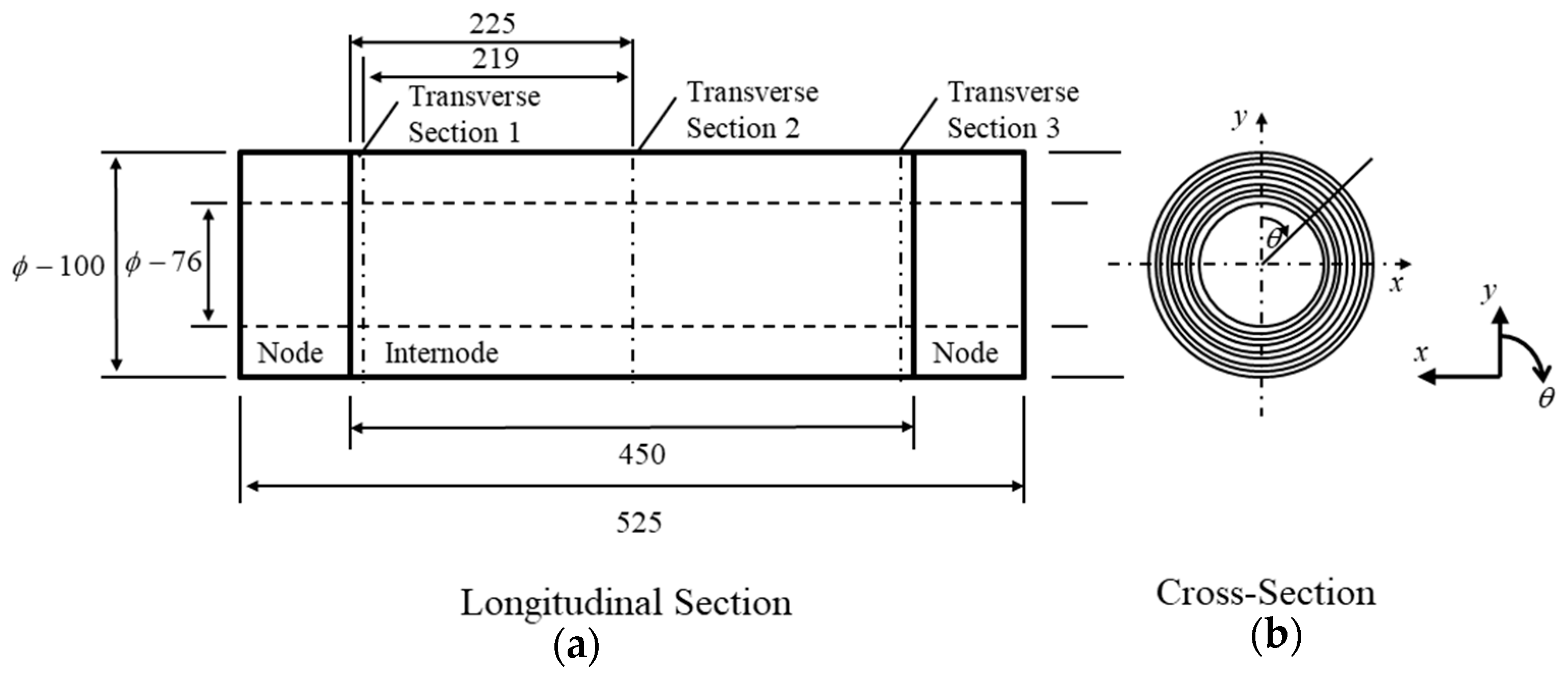



| Specimen | Temp/°C | Weight Loss/% | Radial Shrinkage/% | Tangential Shrinkage/% | Longitudinal Shrinkage/% | ||||||||||||
|---|---|---|---|---|---|---|---|---|---|---|---|---|---|---|---|---|---|
| 24 h | 48 h | 24 h | 48 h | 24 h | 48 h | 24 h | 48 h | ||||||||||
| Mn | CV | Mn | CV | Mn | CV | Mn | CV | Mn | CV | Mn | CV | Mn | CV | Mn | CV | ||
| With Epidermis | 100 | 3.3 | 0.03 | 3.3 | 0.03 | 0.7 | 0.31 | 1.1 | 0.10 | 1.0 | 0.17 | 1.2 | 0.13 | 0.2 | 0.82 | 0.3 | 0.43 |
| 150 | 9.9 | 0.04 | 15 | 0.03 | 1.3 | 0.12 | 2.7 | 0.20 | 1.7 | 0.13 | 2.8 | 0.04 | 0.1 | 0.50 | 0.9 | 0.07 | |
| 200 | 41 | 0.03 | 50 | 0.03 | 17 | 0.03 | 23 | 0.01 | 18 | 0.08 | 23 | 0.12 | 0.6 | 0.52 | 1.1 | 0.10 | |
| Without Epidermis | 100 | 3.4 | 0.01 | 3.4 | 0.01 | 0.6 | 0.35 | 0.7 | 0.30 | 0.9 | 0.14 | 1.1 | 0.16 | 0.3 | 0.65 | 0.4 | 0.74 |
| 150 | 10.0 | 0.03 | 16 | 0.02 | 1.2 | 0.81 | 1.6 | 0.52 | 0.9 | 0.49 | 2.1 | 0.12 | 0.2 | 0.22 | 0.7 | 0.20 | |
| 200 | 41 | 0.03 | 51 | 0.02 | 18 | 0.18 | 24 | 0.06 | 18 | 0.09 | 25 | 0.06 | 0.1 | 0.91 | 1.1 | 0.10 | |
| Peak | Assignment | Frequency (cm−1) | References |
|---|---|---|---|
| 1 | C-C deformation | 423 | |
| 2 | C-H deformation in cellulose | 605 | [40] |
| 3 | C-H deformation of glucose ring in cellulose and hemicellulose | 897 | [40] |
| 4 | C-O, C-H primary alcohol, guaiacyl (lignin) | 1039 | [40] |
| 5 | C-O-C Carbohydrate from hemicellulose | 1160 | [40,41] |
| 6 | Guaiacyl ring breathing with CO-stretching (lignin and hemicelluloses), esters | 1242 | [40,41,42] |
| 7 | C=O free carbonyl groups, Stretching of acetyl or carboxylic acid (hemicelluloses) | 1730 | [40,41,42,43,44,45] |
| 8 | Adsorbed CO2 | 2317, 2351, 2372 | [46] |
| 9 | C-H in Cellulose and hemicellulose stretching | 2945 | [41,45,47] |
| 10 | O-H stretching in Alcohols, phenols, acids, and weakly bounded absorbed water from lignin. | 3400 | [41,45,47] |
| 11 | O-H stretching of adsorbed water and intermolecular bonded OH. | 3566, 3597, 3618 | [46] |
| Thermal Expansion Parameters | ||||||
|---|---|---|---|---|---|---|
| Parameter | Internode | Node | ||||
| Radial | Tangential | Longitudinal | Radial | Tangential | Longitudinal | |
| Change in Length ΔL (%) | 2.17 | 1.67 | 0.17 | 1.73 | 1.33 | 0.13 |
| Coefficient of Thermal Expansion α (K⁻¹) | −1.08 × 10−4 | −8.33 × 10−5 | −8.33 × 10−6 | −8.67 × 10−5 | −6.67 × 10−5 | −6.67 × 10−6 |
| Orthotropic Material Parameters | |||||||||
|---|---|---|---|---|---|---|---|---|---|
| Internode | Node | ||||||||
| Elastic Modulus (MPa) | Poisson’s Ratio | Shear Modulus (MPa) | Elastic Modulus (MPa) | Poisson’s Ratio | Shear Modulus (MPa) | ||||
| EL | ET | νL | νT | GL | EL | ET | νL | νT | GL |
| 15,000 | 675 | 0.3 | 0.0135 | 630 | 30,000 | 1350 | 0.3 | 0.0135 | 1260 |
Publisher’s Note: MDPI stays neutral with regard to jurisdictional claims in published maps and institutional affiliations. |
© 2021 by the authors. Licensee MDPI, Basel, Switzerland. This article is an open access article distributed under the terms and conditions of the Creative Commons Attribution (CC BY) license (http://creativecommons.org/licenses/by/4.0/).
Share and Cite
Ramful, R.; Sunthar, T.P.M.; Zhu, W.; Pezzotti, G. Investigating the Underlying Effect of Thermal Modification on Shrinkage Behavior of Bamboo Culm by Experimental and Numerical Methods. Materials 2021, 14, 974. https://doi.org/10.3390/ma14040974
Ramful R, Sunthar TPM, Zhu W, Pezzotti G. Investigating the Underlying Effect of Thermal Modification on Shrinkage Behavior of Bamboo Culm by Experimental and Numerical Methods. Materials. 2021; 14(4):974. https://doi.org/10.3390/ma14040974
Chicago/Turabian StyleRamful, Raviduth, Thefye P. M. Sunthar, Wenliang Zhu, and Giuseppe Pezzotti. 2021. "Investigating the Underlying Effect of Thermal Modification on Shrinkage Behavior of Bamboo Culm by Experimental and Numerical Methods" Materials 14, no. 4: 974. https://doi.org/10.3390/ma14040974
APA StyleRamful, R., Sunthar, T. P. M., Zhu, W., & Pezzotti, G. (2021). Investigating the Underlying Effect of Thermal Modification on Shrinkage Behavior of Bamboo Culm by Experimental and Numerical Methods. Materials, 14(4), 974. https://doi.org/10.3390/ma14040974





